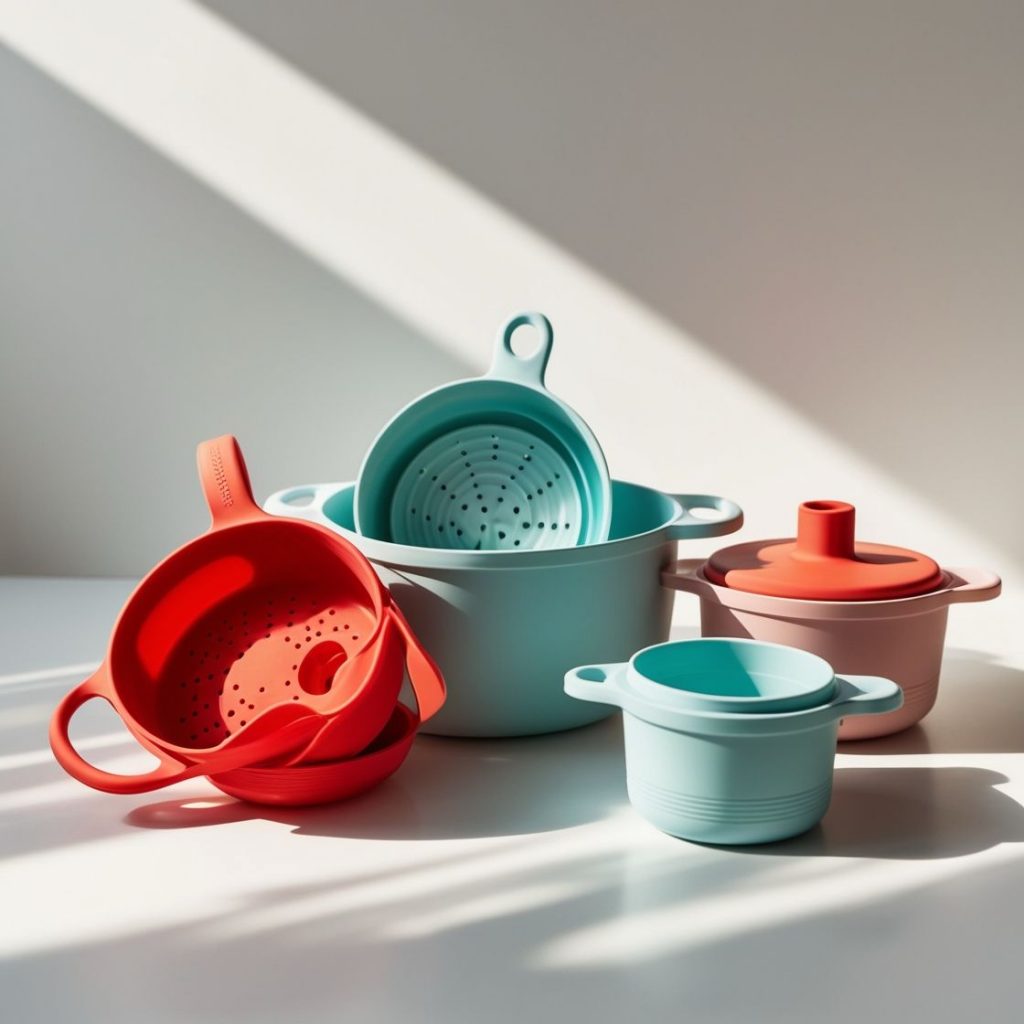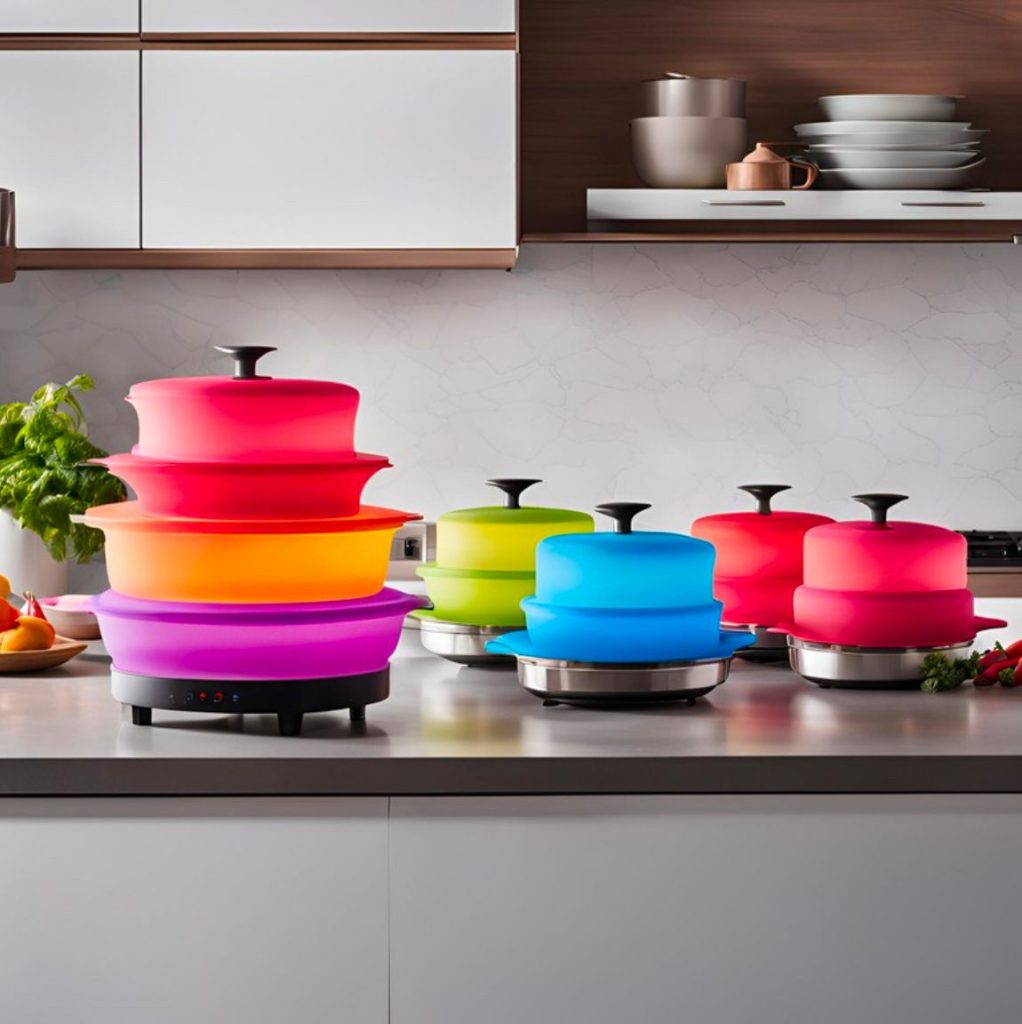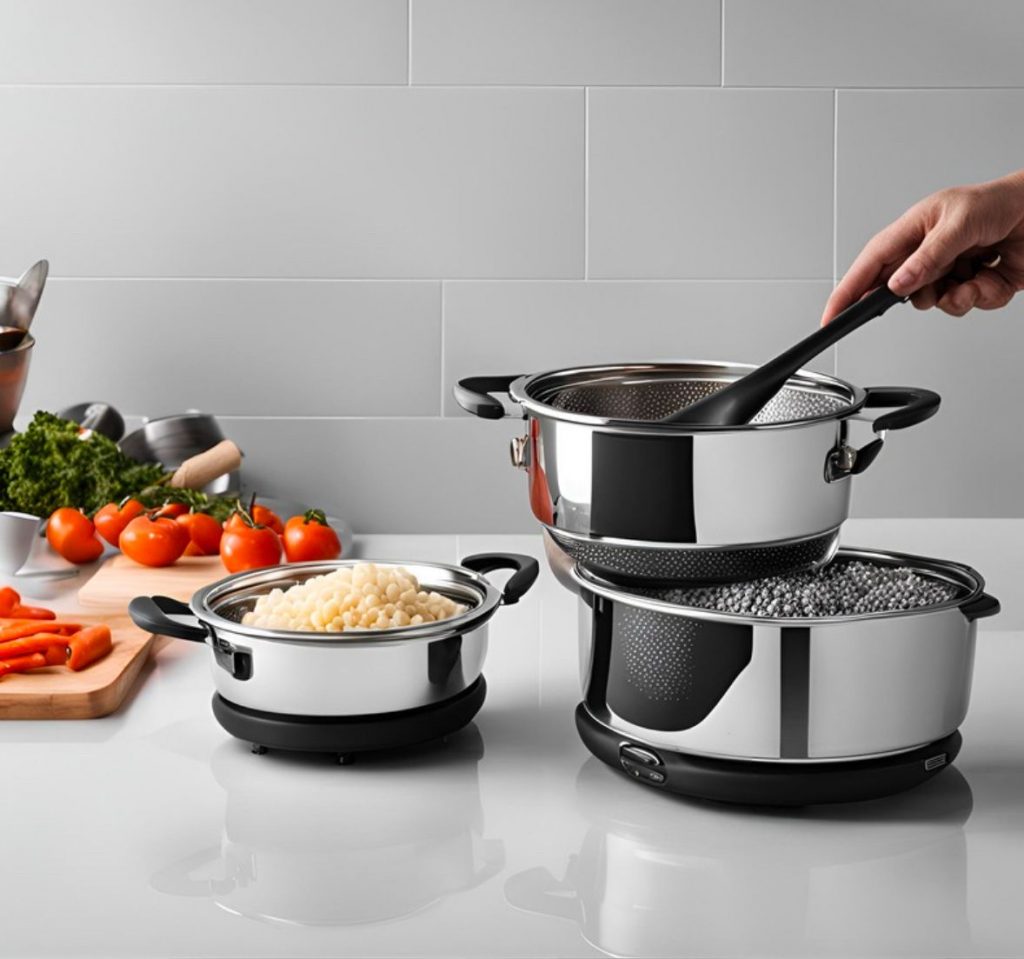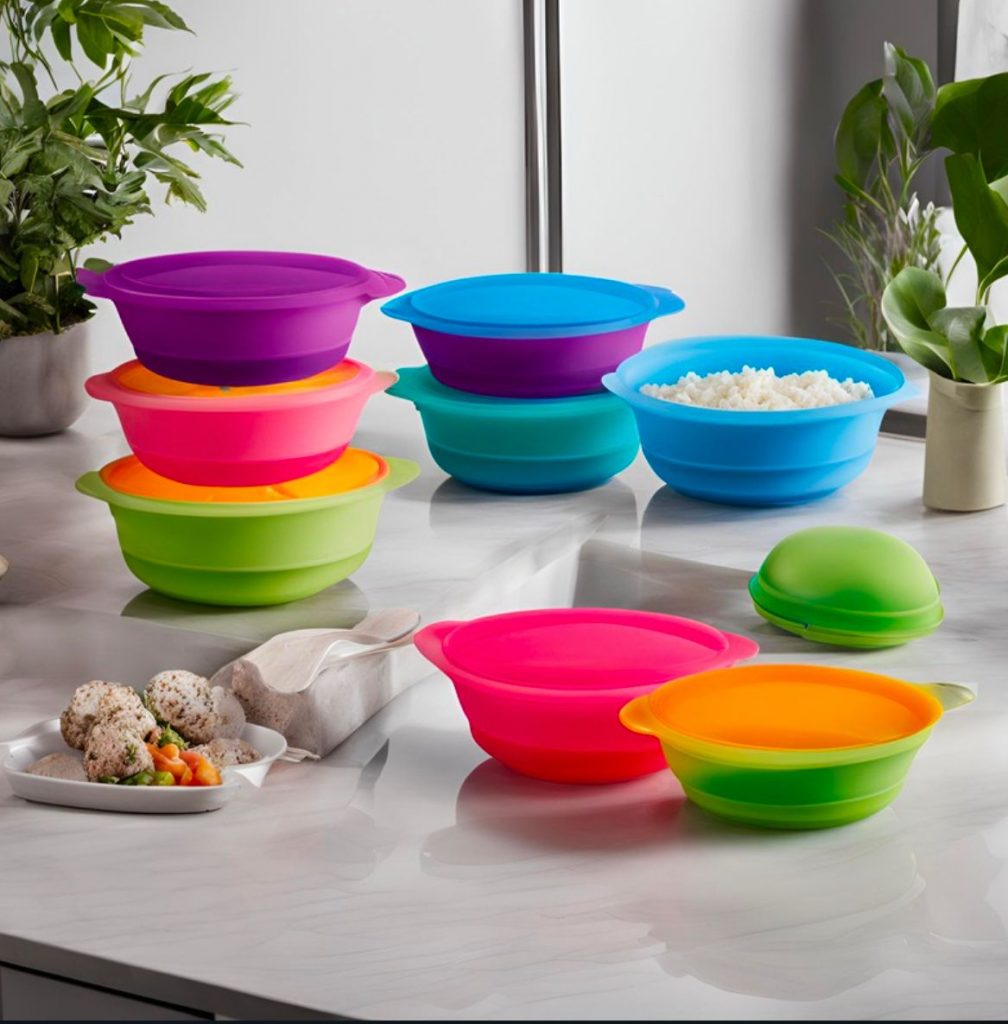Table of Contents

Nothing beats the argument that the materials used when purchasing kitchen tools would make a difference when it comes to convenience, safety, and lifetime. So, is it silicone or metal for your essentials in the kitchen?
This article explores the different aspects of silicone and metal steamers. It will enable you to choose which is better for your cooking needs. Whether you are steaming vegetables or looking at kitchen tools, we will help you find the best choice.
We will compare silicone and metal steamers for heat resistance, durability, safety, and ease of use. Here again, from the best silicone steamer baskets to questions like “Are silicone steamers safe?” or “Are silicone or metal straws better?”
Understanding the Basics: What Are Silicone and Metal Steamers?
A steamer is a very handy kitchen appliance. It is intended to cook food by steam, which is much healthier. It preserves the nutrients and flavor of food. Whether it’s green veggies or seafood, steamers find their way into every kitchen to ensure perfect preparation with less oil.
- Silicone steamers:
Modern silicone steamers have become very popular. Thanks to their flexibility, lightweight, and heat resistance. These are easy to clean, can be placed in a dishwasher, and are very portable. Their non-stick feature also allows food to come out easily. They ensure durability due to extreme temperature resistance.
they are safe and environment friendly. Silicone vegetable steamers are safe and eco-friendly options for health-conscious cooks, who still ask themselves, “Are silicone steamers safe? For sure!
Silicone steamers are made from food-grade silicone. They guarantee their safe and confident use in the kitchen.

- Metal Steamer:
The old reliable metal steamers maintain some durability and display a classic aesthetic. They are often made of stainless steel or aluminum. These can be heated up very rapidly to ensure complete steaming of almost any type of food. Good for heavy-duty tasks like steaming seafood or dumplings, metal steamers remain the norm in most homes.

Why Are Both Types Popular?
Silicone steamers are amazingly adaptable, but metal steamers have unbelievable resilience. These suit a particular type of taste, and the argument for silicone versus metal straws is decidedly parallel to modern versus traditional kinds of cookware.
Therefore, the imperative to choose the best silicone steamer basket has much to do with the personal requirements and usual practices of a user. Whether it is to select the best silicone steamer or pondering “What’s better, silicone or metal straws?”, they both have their sets of strengths. Let’s discover more about it.
Difference between silicone and metal steamers
While comparing silicone with metal, it appears that each material has a particular strength point suitable to specific cooking needs. So here’s how they compare:
- Materials and Manufacturing
Generally, silicon steamers are flexible and soft with a non-stick surface. They add versatility to kitchen tasks since they are friendly with very delicate foods and are easily cleaned. Metal steamers, preferably stainless steel or aluminum, are rigid and sturdy and weigh more. They can be quite durable since the solid structure does not compromise on robustness. On the other hand, they do not offer the ease of handling that silicon provides.
- Heat Resistance and Durability
Silicone steamers are also quite heat-resistant up to extreme temperatures. Metal steamers are relatively durable and are prone to wear and tear. They are hard, though, metal does need upkeep-not to let rust when not in use when damp.
- Weight and Portability
In contrast, the silicone steamers are lightweight and easy to manage. They are perfect for small kitchens or convenience-loving cooks. They can be compact enough to fit into a drawer.
In contrast, metal steamers are significantly bulkier and heavier. They need more storage space and care when handling. They may cater to entirely different cooking styles. At the same time, silicone shines and is non-stick. Metal steamers will shine in their long-term durability. Be it the best silicone steamer basket or the reliability of metal, both options may elevate your streaming experience.
A curious mind would wonder which is better: silicone or metal straws? Both exhibit somewhat similar features across kitchen tools.
Performance and Efficiency in the Kitchen
The difference between these debate presenters of silicone vs. metal steamers lies in their different properties and results in cooking.
Distribution of heat:
The most popular metal steamers are the ones with efficient conduction and distribution of heat. Silicone steamers, although somewhat slower to heat up because of their insulating properties. They keep heat very well for a much longer time when food is cooked.
Steaming Capacity:
Metal steamers often come with larger capacities. That makes them suitable for steaming bigger portions. The best silicone steamer or steamer basket shines in compact kitchens.
Cooking Results
Foods cooked in silicone steamers keep more moisture in cooking. it provides softer textures for delicate veggies. Metal steamers, with superior conductivity, produce firmer textures. So perfect where a few extra degrees are desired.
Wondering if silicone vegetable steamers are safe or not? They are safe. Food-grade silicone steamers are BPA-free. So, be it silicone vs metal whisk or pondering what’s better, silicone or metal straws, your decision depends on your needs. Every material brings something special and thus is valuable for the kitchen.
Cleaning and Maintenance of Steamers
Rubber steamers come out a clear winner when it comes to easy cleaning. These don’t stain easily and are resistant to smells. Most of them can even be washed in the dishwasher, making these really easy to take care of.
But, metal steamers are harder to clean because food sticks to them. They rust easily if they are not let dry after cleaning. They need careful long-term handling.
Silica steamers are durable. Silica steamers need to be inspected for possible wear and tear, whereas metal ones require deep drying and storage in a dry place.
Safety Considerations: Which is Safer for Your Kitchen?
- Silicone Steamers:
Between silicone steamers and metal steamers, the former generally have varying advantages about the safety of a kitchen. Silicone steamers are non-toxic, meaning they are BPA-free. They do not transfer chemicals into food when heated. So, they can be trusted to cook vegetables. The most asked question is, “Are silicone steamers safe for cooking?”
The answer is: Yes, silicone steamers are safe. They can withstand very high temperatures.
- Metal Steamers:
But, metal steamers especially stainless steel are generally safe too. Yet, the aluminum type could sometimes react with some acidic foodstuffs. This could lead to health problems. To cut it short, some metal steamers have non-stick coatings which tend to wear out eventually making one question about long-term safety.
The main safety differences between silicone and metal straws and also between silicone and metal whisks are pretty much the same. In every case, silicone options are softer and safer for children, while metal straws are a risk because of their rigidity and are liable for injury.

Cost-Effectiveness: Which One Promises the Best Value?
By comparing silicone with metal, cost-effectiveness is where at least the homestyle cook will want to weigh the value against functionality.
Silicone Steamers
Silicone is a front-end option that is cheaper upfront, which is exactly why they are so appealing to the frugal shopper. It does depend on usage and care, however. For the lighter cook or those with less kitchen space, a silicone option-the finest silicone steamer basket would be an excellent value. They’re lightweight, flexible, and versatile-but because they are so soft, they may not be workable with heavy or extended use.
Metal Steamer
Of course, metal steamers, stainless steel if you want the good stuff, cost a bit more out of the gate but are a good choice for people who cook often because they’re much more resistant to long-term usage and high heat, and heavy food. If you steam vegetables often or need to cook a lot of vegetables at once, a metal steamer will be better for you.
Long-term value
Of course, the final choice between silicone and metal steamers comes down to your cooking. For someone who cooks much, then silicone might be the best choice for daily steaming or more brutal kitchen usage. The reliability is in the long run.
Environmental Impact: Which Is More Eco-Friendly?
Both materials hold qualities when comparing the environmental implications of silicone steamers and metal steamers. Silicone is more eco-friendly. Silicone is synthetic rubber; it’s durable but not biodegradable. So this creates an issue with vast long-term waste. Conversely, most metal steamers are made from stainless steel, which can be recycled and lasts much longer, thus requiring fewer replacements.
A sustainable consumer may prefer a silicone steamer. They can be recycled and are durable. Ultimately, it is their personal choice based on what they hold dear for sustainability and responsibility to the environment.

InSilicone: Your One-Stop Solution for Silicone Rubber
Silicone steamers make your life more easy and comfortable. They are easy to use and wash. You don’t have to wash the silicone steamers vigorously as the intense scrubbing drains the energy. InSilicone is your effective solution for silicone steamers.
If you want to cook with confidence, InSilicone offers the best steamers. These steamers will redefine your kitchen. Say goodbye to bulky cookware and welcome InSilicone steamers.
Wrapping up
Both silicone and metal steamers have certain advantages. However, silicone steamers are more lightweight, flexible, and easy to clean. They are safe and durable as well. They can be recycled and occupy less space. Silicone steamers are safe and BPA-free. Whereas, metal steamers are way too heavy and occupy a lot of space in your kitchen cabinet. They are prone to rust whereas silicone steamers are not prone to rust.